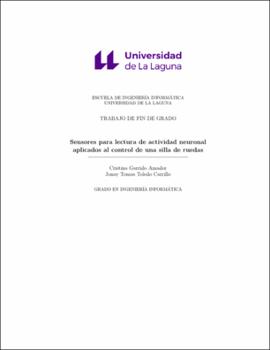Sensores para lectura de actividad neuronal aplicados al control de una silla de ruedas
Autor
Garrido Amador, CristinaFecha
2020Resumen
El proyecto desarrollado se centra en la utilizaci´on de sensores de actividad el´ectrica colocados en la cabeza
de un usuario de silla de ruedas. Estos sensores son utilizados para leer ondas cerebrales con la intenci´on de
diferenciar distintos gestos. El objetivo es desarrollar un interfaz persona-computador a trav´es de dichos sensores,
de tal forma que si el usuario realiza distintos gestos, el software reconoce y diferencia el gesto realizado.
Esta detecci´on de gestos se pretende utilizar para realizar una interfaz que, a partir de estas se˜nales, genere
comandos para mover una silla de ruedas inteligente de manera aut´onoma, donde la direcci´on de movimiento
depender´a del gesto que el usuario haya efectuado.
Los datos a analizar se reciben gracias a los sensores que se colocan en la parte delantera del cr´aneo de la
persona, quien deber´a repetir los mismos gestos varias veces para poder analizar las ondas espec´ıficas asociadas
a cada gesto. De esta manera se podr´an traducir estos gestos a comandos de la silla de ruedas.
Una vez se han distinguido las se˜nales y se tiene el estudio creado, se asocian acciones con dichos gestos,
de manera que cada mueca se corresponda con una maniobra, es decir, si el usuario desea ir a la izquierda debe
cerrar ´unicamente el ojo izquierdo. De esta forma, cada vez que desee hacer dicha acci´on deber´a repetir el gesto.
Para ejecutar esta parte se actualiza el c´odigo principal y se asocia el gesto con el movimiento.
Finalmente, a pesar de que el objetivo en s´ı mismo no se alcanz´o, se ha de resaltar que se acot´o notablemente
la v´ıa de investigaci´on para lograr una silla de ruedas dirigida ´unica y exclusivamente a trav´es de gestos faciales.
El problema reside en que, a pesar de que cada sensor obten´ıa una onda, estas eran muy semejantes, por
lo que resultaba muy complejo distinguirlas en el momento del an´alisis.
Asimismo, hay que destacar el n´umero de sensores utilizados, pues al reducirse a cuatro, colocados en la
parte frontal de la cabeza, la sensibilidad de las ondas para captar la informaci´on era muy reducida. As´ı pues,
se considera fundamental trabajar con un mayor n´umero de sensores dispuestos de tal forma que abarquen un
n´umero superior de zonas cerebrales. The project developed focuses on the use of electrical activity sensors placed on the head of a wheelchair
user. These sensors are used to read brain waves in order to differentiate between different gestures. The objective
is to develop a person-computer interface through these sensors, so that if the user makes different gestures, the
software recognizes and distinguishes the gesture made.
This gesture detection is intended to be used to make an interface that, from these signals, generates
commands to move an intelligent wheelchair autonomously, where the direction of movement will depend on
the gesture made by the user.
The data to be analysed is received thanks to sensors placed in the front of the person’s skull, who must
repeat the same gestures several times in order to analyse the specific waves associated with each gesture. In
this way these gestures can be translated into wheelchair commands.
Once the signals have been distinguished and the study has been created, actions are associated with these
expressions, so that each grimace corresponds to a manoeuvre, i.e. if the user wishes to go to the left he must
only close his left eye. In this way, every time he wants to do that action he must repeat the gesture. To execute
this part, the main code is updated and the expression is associated with the movement.
Finally, despite the fact that the objective itself was not reached, it should be noted that the research path
to achieve a wheelchair directed solely and exclusively through facial gestures was significantly limited.
The problem is that, although each sensor obtained a wave, these were very similar, so it was very complex
to distinguish them at the time of analysis.
Also, the number of sensors used should be highlighted, since when reduced to four, placed in the front
of the head, the sensitivity of the waves to capture the information was very low. Therefore, it is considered
essential to work with a greater number of sensors arranged in such a way that they cover a greater number of
brain areas.





